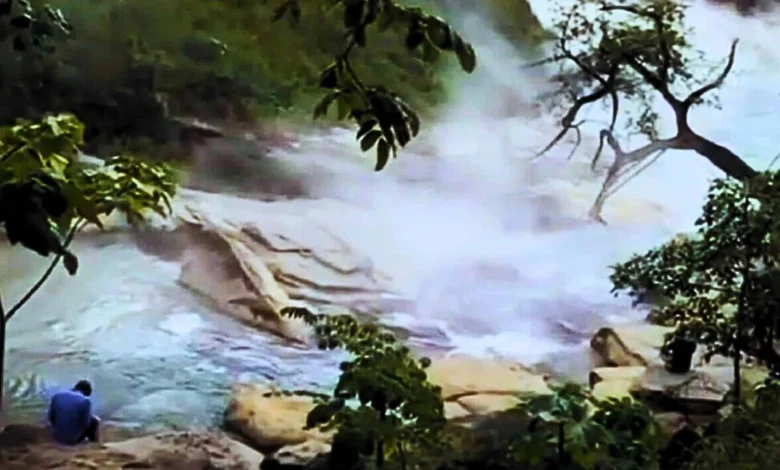Amazon River Water Reaches 90°C, Boiling Wildlife Alive in One of Earth’s Most Extreme Natural Hotspots

Deep in the Peruvian Amazon, a stretch of river runs hot enough to cook animals alive. Water temperatures recorded along its banks often range between 80°C and 95°C (176°F to 203°F), with occasional spikes to boiling. Fish perish instantly, and small mammals that fall in die within seconds. Locals call it Shanay-Timpishka, meaning “boiled with the heat of the sun.” What science has since confirmed is that this isn’t an exaggeration or a metaphor—this river is one of Earth’s most extreme thermal outliers, and its existence is forcing geologists to reconsider the boundaries of geothermal behavior.
Frogs’ eyes turn white as the water boils them alive. Credit: The Sun
What makes Shanay-Timpishka remarkable isn’t just its lethality—it’s its geography. The river lies in a non-volcanic zone, more than 700 kilometers from the nearest tectonic boundary or volcanic system, as detailed in a report by The Sun. This contradiction—extreme geothermal temperatures without any magma source—has puzzled scientists since the river was first brought to global attention by geophysicist Andrés Ruzo, who chronicled its discovery in his 2016 book The Boiling River.
Deep Heat Without Volcanoes
The river’s heat isn’t caused by ambient conditions or volcanic activity. According to Ruzo’s fieldwork, and later confirmed by a 2022 study led by Riley Fortier, a doctoral researcher at the University of Miami, the river is heated through a mechanism known as deep hydrothermal circulation. Rainwater infiltrates porous fault zones, descends thousands of meters beneath Earth’s surface, and is superheated by geothermal energy. The water then resurfaces rapidly through fissures, emerging at near-boiling temperatures.
The Shanay Timpishka Is More Popularly Known As The ‘boiling River Of The Amazon’. Credit: YouTube/ ANIMAL TUBE
Fortier’s team used infrared thermography, drone imaging, and in-ground temperature sensors to measure the thermal landscape surrounding the river. Their research, published in collaboration with regional institutions, showed a direct correlation between surface heat anomalies and sparse vegetation. Trees near the hottest parts of the river were visibly stressed or entirely absent, and soil moisture was abnormally low—strong evidence that the heat source is subsurface and sustained, not seasonal or weather-dependent.
“This isn’t a shallow heating event,” Fortier noted in field interviews cited by The Daily Galaxy. “The intensity and permanence of the thermal gradient point to something deeper—literally.”
A Biological Dead Zone
While it may be a geological wonder, the Shanay-Timpishka is also a death trap for wildlife. As described by Ruzo and confirmed in multiple field accounts, animals that wander too close often don’t survive. Frogs are reportedly the most frequent victims, their eyes turning opaque almost immediately before they are overwhelmed by the heat. Small rodents, snakes, and even some birds have been found lifeless in the shallows.
Aquatic life fares no better. Entire sections of the river are biologically sterile, lacking the fish, crustaceans, and insects typically found in Amazonian waterways. The surrounding ecosystem bears the scars of this heat: dry underbrush, cracked earth, and a visible absence of moisture-loving plant species, all of which were documented in Fortier’s 2022 thermal maps.
In the context of tropical biodiversity, such a barren pocket is almost unheard of. The region offers a stark contrast to the surrounding rainforest and raises questions about how temperature extremes might drive localized ecological collapse.
Traditional Warnings, Modern Insight
Long before geologists arrived with thermal drones and data models, the local Asháninka communities knew the river was different. Their oral histories warned of spirits and a river that punished those who approached carelessly. The name Shanay-Timpishka has existed for generations, and was part of the reason Ruzo, then a geology graduate student at Southern Methodist University, first ventured into the jungle to find the source of his grandfather’s childhood stories.
In his book and TED Talk, Ruzo emphasized the value of Indigenous knowledge in locating and understanding natural phenomena. “Without the stories,” he wrote, “I wouldn’t have believed it. I wouldn’t have looked.” That mix of tradition and science, he argues, offers a template for better environmental research going forward.
A Glimpse Into Climate Extremes
Though the boiling river isn’t directly linked to climate change, some researchers believe it functions as a living model for how ecosystems might respond to prolonged extreme heat. The drying of soils, dieback of trees, and reduction in biodiversity around Shanay-Timpishka resemble the kinds of shifts predicted under global warming scenarios.
A 2017 editorial in Nature Climate Change emphasized the importance of studying “natural microclimates”—unique environments that may preview broader ecological futures. Similarly, projections from the Intergovernmental Panel on Climate Change (IPCC) suggest that even a 2°C global increase could lead to large-scale disruptions of the Amazon’s hydrological and ecological systems. Observing a real-world, heat-stressed rainforest system—however local—offers scientists a rare test case.
Fortier’s team is now comparing thermal stress indicators from Shanay-Timpishka with satellite data across the Amazon Basin. Early findings suggest that vegetation stress patterns seen around the boiling river may already be emerging in drier regions of the forest.




